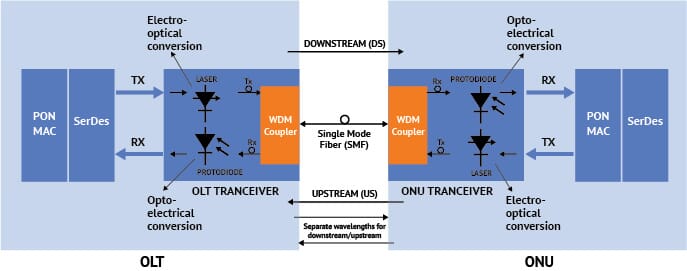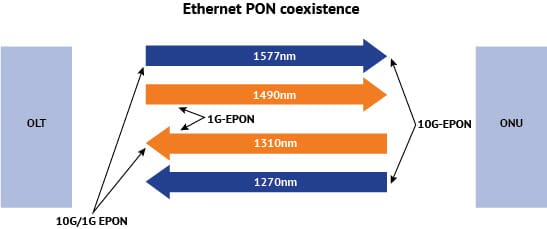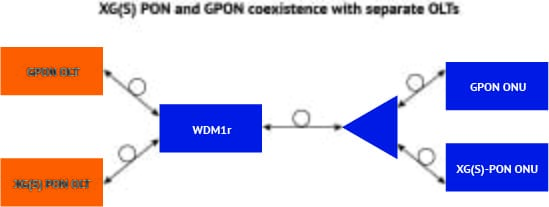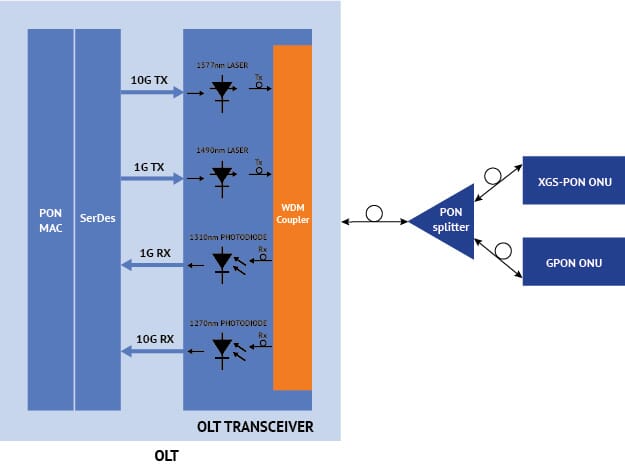The demand for higher bandwidth and lower latency by residential users of Fiber To The Home (FTTH) has been driving forward the evolution of Passive Optical Network (PON) technologies.
A particular challenge with PON is that newer, faster versions have not been designed to be fully backwards compatible. How can operators gradually roll out new PON technology, while minimizing the need for new equipment and infrastructure, as well as reducing disruption to subscribers on the same link who are not upgrading? Somehow, data transmissions for old and new PON technology must co-exist on the shared fiber.
Overview of end-to-end communication in PON
In PON end-to-end communication, the OLT and ONU transceivers perform opto-electrical conversions and vice versa. The PON PHY is the first stage of PON processing in the OLT and includes the transceiver and a Serializer/Deserializer (SerDes) circuit. The PON MAC is the second stage and encodes and decodes the data frames, the PHY layer transmits and receives these frames through the communications channel, in this case an optical fiber.

To understand if two PON technologies can co-exist, there are two aspects to consider: The light wavelengths used and the data format (frame structure).
Optical separation – WDMA Coexistence
When sufficiently different wavelengths are used (downstream and upstream), separation is achievable directly in the optical (photonic) domain using appropriately tuned lasers and photodetectors. This method is known as Wavelength Division Multiple Access (WDMA) Coexistence.
For instance, XGS-PON and GPON are invisible to each other as can be seen in the diagram below:

Electrical separation – TDMA Coexistence
If the same wavelengths are used by the different PON technologies, such as XGS-PON and XG-PON, co-existence can be achieved if the framing format is compatible (in this case X-Gem), such that:
- In the upstream direction, the OLT PON PHY and MAC stages can extract and differentiate the data transmissions from either type of ONU.
- In the downstream direction, the ONU PON PHY and MAC stages can ignore transmissions related to a technology that it does not support.
In the downstream direction, the speed is the same in both cases (10Gbps), therefore ONUs have no issues decoding the transmissions and ignoring any frames for other than their own XGEM Port ID. In the upstream direction, speeds are different (10Gbps vs 2.5 Gbps), therefore the OLT PON PHY receive stage must be designed to handle both speeds.
Combination of WDMA and TDMA coexistence
There are also cases where the two coexistence methods described earlier need to be combined, such as Ethernet PON technology, where 1G EPON, asymmetric 10G-EPON (10G/1G) and symmetric 10G-EPON use different combinations of four wavelengths, as it can be observed in the diagram below:

Fortunately, the framing format is compatible between the 3 variants, based on a Logical Link Identifier (LLID) that allows the differentiation of transmissions to/from individual ONUs.
Next, let us consider how co-existence can be implemented in practice, and what it depends on in terms on OLT capabilities.
Separate OLTs
One option for WDMA coexistence is to deploy separate sets of OLTs for each PON technology, along with additional equipment known as WDM1r wavelength combiners to separate the signals (wavelengths). However, there is additional cost for operating two sets of OLTs. Another drawback is that the WDM1r devices introduce an extra optical power loss.

Dual Mode OLTs
With recent advances in OLT chipset and transceiver technology, a new option allows a single OLT to support multiple technologies on the same PON link using both WDMA and TDMA coexistence without additional equipment. This method requires support in the PON MAC and SERDES stages of the OLT, as well as a dual-mode transceiver. The next figure illustrates this concept for connecting XGS-PON and GPON ONUs to the same PON splitter and same OLT port:

An example of such technology is the latest PON chipset from Broadcom, the BCM68650 (ASPEN). When equipped with the appropriate transceivers, OLTs based on the ASPEN chipset can support a wide variety of combinations of PON co-existence across its ports, such as those provided in the previous examples:

At IP Infusion, we are already working with the ASPEN chipset. It is also worth noting that in addition to multiple co-existence modes, ASPEN increases the number of ports supported for XGS-PON from 2 to 16, compared to its precursor, the BCM68620 (MAPLE).
If you are an OLT vendor starting to use the ASPEN chipset, or if you are implementing coexistence mode on your own, such as using an FPGA solution, we can assist with our vast expertise in PON, as well as our strong knowledge of Broadcom’s Broadband Adaptation Layer (BAL), an SDK which creates an abstraction for easily configuring both the PON MAC and switching chipset of an OLT. Our experience with PON and BAL ranges from fully monolithic, proprietary OLTs to totally open source, SDN-controlled solutions, such as openCORD/VOLTHA.

